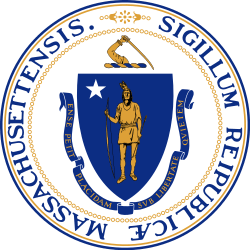Edward Robbins
Edward Hutchinson Robbins (February 9, 1758 – December 17, 1837) was an American lawyer and politician who served as the sixth Lieutenant Governor of Massachusetts from 1802 to 1806.
Edward Hutchinson Robbins | |
|---|---|
 | |
| 6th Lieutenant Governor of Massachusetts | |
| In office 1802–1806 | |
| Governor | Caleb Strong |
| Preceded by | Samuel Phillips Jr. |
| Succeeded by | Levi Lincoln Sr. |
| Speaker of the Massachusetts House of Representatives | |
| In office 1793–1802 | |
| Preceded by | David Cobb |
| Succeeded by | John Coffin Jones Sr. |
| Personal details | |
| Born | February 9, 1758 Milton, Province of Massachusetts Bay, British America |
| Died | December 17, 1837 (aged 79) Milton, Massachusetts, U.S. |
| Political party | Democratic-Republican |
| Spouse(s) | Elizabeth Murray (m. 1785–1837) |
| Children | 7 |
| Alma mater | Harvard College |
| Profession | Lawyer, politician |
Early life
Robbins was born on February 9, 1758 in Milton, Province of Massachusetts Bay in what was then British America. He was the son of Rev. Nathaniel Robbins (1726–1795) and Elizabeth (née Hutchinson) Robbins (1731–1793). His mother was married to Caleb Chappel Jr. Among his siblings was Lydia Robbins and Nathaniel Johnson Robbins.
His paternal grandparents were Thomas Robbins and Ruth (née Johnson) Robbins. His maternal grandparents were Lydia (née Foster) Hutchinson and Edward Hutchinson, a grandson of Capt. Edward Hutchinson (and his parents, magistrate William Hutchinson and Anne Hutchinson).[1]
He graduated from Harvard College in 1775.[2]
Career
After his graduation, he became a lawyer, a delegate to the Massachusetts Constitutional Convention.[2]
On October 21, 1786, Robbins and his brother Nathaniel received a land grant for the purchase and settlement of lands in Passamaquoddy, now in Maine. The town of Robbinston on the St. Croix River was named in his honor.[2]
Political career
Robbins was a member of the Massachusetts House of Representatives and from 1793 until 1802, he was the Speaker of the House. From 1802 to 1806, Robbins served under Governor Caleb Strong as the sixth Lieutenant Governor of Massachusetts.[2]
In 1811, he was appointed judge of probate for Norfolk County.[2]
Personal life
_-_1984.503_-_Museum_of_Fine_Arts.jpg)
In 1785, Robbins was married to Elizabeth Murray (1756–1837), daughter of James Murray and Barbara (née Bennet) Murray.[3] Her sister, Dorothy "Dolly" Forbes, was married to Rev. John Forbes and was the mother of diplomat John Murray Forbes.[4] Together, Edward and Elizabeth were the parents of:[3]
- Elizabeth Robbins (1786–1853)
- Sarah Lydia Robbins (1787–1862), who married Judge Samuel Estes Howe (1785–1828).[5][6]
- Anne Jean Robbins (1789–1867), who married Judge Joseph Lyman III (1767–1847).[7]
- Edward Hutchinson Robbins (1792–1850), who married Louisa Anne Coffin (1795–1854).[8]
- Mary Robbins (1794–1879), who married Joseph Warren Revere (1777–1868), a son of Paul Revere, in 1821.
- James Murray Robbins (1796–1885), who married Frances Mary Harris (1796–1860), daughter of Abel Harris and Rooksby Coffin. He entered into partnership with his cousin John Murray Forbes to conduct business in Europe and later became a Massachusetts state representative and senator.[2]
- Catherine Robbins (1800–1884).
In 1799, he was elected a Fellow of the American Academy of Arts and Sciences.[9]
Robbins died on December 17, 1837 in Milton, Massachusetts.
Descendants
Through his granddaughter, Catherine Robbins Lyman (the wife of Warren Delano Jr.), he is the great-grandfather of Sara Delano (the wife of James Roosevelt) and the great-great-grandfather of President Franklin Delano Roosevelt.[10]
References
- Winsor, Justin; Jewett, Clarence F. (1881). The Memorial History of Boston: Including Suffolk County, Massachusetts. 1630-1880. Ed. by Justin Winsor. J. R. Osgood and Company. p. 539. Retrieved 24 April 2019.
- "Murray-Robbins Family Papers, 1658-1944". www.masshist.org. Massachusetts Historical Society. Retrieved 24 April 2019.
- Murray, James (1901). Letters of James Murray, Loyalist. printed: not published. pp. 289, 295. Retrieved 24 April 2019.
- "Forbes Family Papers, 1732-1931". www.masshist.org. Retrieved 2017-07-06.
- Cutter, William Richard (1908). Historic Homes and Places and Genealogical and Personal Memoirs Relating to the Families of Middlesex County, Massachusetts. Lewis historical publishing Company. p. 1885. Retrieved 24 April 2019.
- Dwight, Benjamin Woodbridge (1874). The History of the Descendants of John Dwight of Dedham, Mass. J.F. Trow & Son, printers. p. 480. Retrieved 24 April 2019.
- Whalen, Joseph (2002). The Stipp and Brown Family Tree. Gateway Press. pp. 129–130. Retrieved 24 April 2019.
- Sibley's Harvard Graduates: Biographical Sketches of Those who Attended Harvard College ... with Bibliographical and Other Notes. 1772-1774. Massachusetts Historical Society. 1999. p. 49. ISBN 9780934909778. Retrieved 24 April 2019.
- "Book of Members, 1780–2010: Chapter R" (PDF). American Academy of Arts and Sciences. Retrieved August 7, 2014.
- Bergen, Tunis Garret (1915). Genealogies of the State of New York: A Record of the Achievements of Her People in the Making of a Commonwealth and the Founding of a Nation. Lewis Historical Publishing Company. p. 1061. Retrieved 24 April 2019.
External links
- Judge Edward Hutchinson Robbins, by Chester Harding, 1827.
| Political offices | ||
|---|---|---|
| Preceded by Samuel Phillips Jr. |
Lieutenant Governor of Massachusetts 1802–1806 |
Succeeded by Levi Lincoln Sr. |
| Preceded by David Cobb |
Speaker of the Massachusetts House of Representatives 1793–1802 |
Succeeded by John Coffin Jones Sr. |
